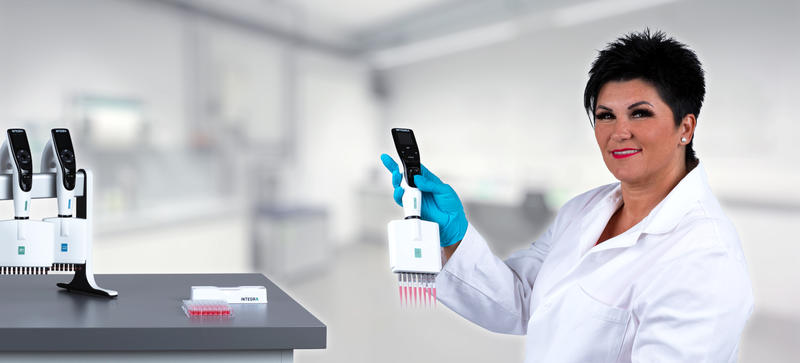-
Automating the Oxford Nanopore Ligation Sequencing Kit on MIRO CANVAS®
Effortless long read sequencing library prep
Long read sequencing is particularly well suited for detection of large genomic mutations, coverage of long repeat regions that confound short read assemblies,¹ and identification of signatures that can be lost due to PCR amplification (including relative abundance in metagenomic samples² and nucleotide modifications present on original DNA).³
Oxford Nanopore Technologies (ONT) long read sequencing of single-stranded DNA and RNA moving through nanoscale pores has been a major technological achievement in genomic research.³,⁴ Its advantages include the use of a small, portable sequencer that can be deployed in the laboratory or the field, low capital cost requirements, rapid turnaround times, and a user-friendly bioinformatics pipeline that allows real-time analysis during sequencing.²
MIRO CANVAS is a digital microfluidics (DMF) platform that allows low throughput workflow automation for complex protocols, such as NGS library preparation. The system is compatible with a wide range of reagents. This application note describes the results that can be expected when using the ONT Ligation Sequencing Kit in a protocol developed for the MIRO CANVAS. The resulting research use only libraries can then be sequenced using ONT sequencing platforms.
-
Table of contents
Long read sequencing is particularly well suited for detection of large genomic mutations, coverage of long repeat regions that confound short read assemblies,¹ and identification of signatures that can be lost due to PCR amplification (including relative abundance in metagenomic samples² and nucleotide modifications present on original DNA).³
Oxford Nanopore Technologies (ONT) long read sequencing of single-stranded DNA and RNA moving through nanoscale pores has been a major technological achievement in genomic research.³,⁴ Its advantages include the use of a small, portable sequencer that can be deployed in the laboratory or the field, low capital cost requirements, rapid turnaround times, and a user-friendly bioinformatics pipeline that allows real-time analysis during sequencing.²
MIRO CANVAS is a digital microfluidics (DMF) platform that allows low throughput workflow automation for complex protocols, such as NGS library preparation. The system is compatible with a wide range of reagents. This application note describes the results that can be expected when using the ONT Ligation Sequencing Kit in a protocol developed for the MIRO CANVAS. The resulting research use only libraries can then be sequenced using ONT sequencing platforms.
Key benefits
- Library preparation using the 1D ONT Ligation Kit is fully automated on the MIRO CANVAS.
- 75 % reduction in reaction volumes compared to manual library preparation.
- This protocol has been demonstrated on MIRO CANVAS using 1 μg of high quality, high molecular weight input DNA.
- 2 hr 30 min run time.
- N50 comparable to manual library prep.
Overview: How to automate the ONT Ligation Sequencing Kit on MIRO CANVAS
Experimental set-up
The protocol was designed for fully automated use on the MIRO CANVAS, and has been tested using 1 μg of high quality, high molecular weight (HMW) input DNA. Before beginning, DNA should be quantified using a broad range Qubit quantification kit or similar. DNA repair and end prep, post repair bead clean-up, adapter ligation and library clean-up are all automated on the MIRO CANVAS (Figure 1). Downstream quantification requires additional hands-on time.
Downloads: App note for automating the Oxford Nanopore Ligation Sequencing Kit on MIRO CANVAS®
Results
For both manual library preparation and libraries prepared on the MIRO CANVAS, 1 μg of ZymoBIOMICS HMW DNA standard was used as input. For both preparation types, volumes listed in the ONT Genomic DNA by Ligation Protocol were reduced by 75 %. Each prepared library was loaded into a MinION flow cell and sequenced for up to 3 hours. Libraries prepared using the automated workflow on the MIRO CANVAS produced comparable read length distributions (Figure 2) and N50 read lengths (Table 1) to those prepared using the manual technique.
Table 1: Summary of the sequencing metrics for libraries prepared manually and using the MIRO CANVAS. Representative sequencing metrics for libraries prepared manually and using the MIRO CANVAS are shown below. Read length and quality statistics are comparable between MIRO CANVAS and manual preparation.
The five longest sequenced reads in the MIRO CANVAS library were all longer than 120 kb, and of similar length to the five longest ranked reads from the manually prepared library. Additionally, the longest read from the MIRO CANVAS library exceeded the length of the longest read from the manually prepared library, and had a higher mean call base quality score (Figure 3).
The ZymoBIOMICS HMW DNA standard is composed of genomic DNA from seven bacteria and one yeast species. All of the eight expected species were identified through nanopore sequencing of libraries prepared both manually and using the MIRO CANVAS. Figure 4 shows how the cumulative reads of each species compare between manual and MIRO CANVAS runs.
Due to its compact nature, simple set-up and minimal infrastructure requirements (a 120V adapter), the MIRO CANVAS can support scientists outside of the laboratory and facilitate collaboration between working groups. The MIRO CANVAS has been tested after air travel in carry-on baggage and in a backpack (Figure 5).
References
- Wick RR, Judd LM, Gorrie CL, Holt KE. Completing bacterial genome assemblies with multiplex MinION sequencing. Microbial genomics. 2017 Sep 14;3(10):e000132. doi: 10.1099/mgen.0.000132. eCollection 2017 Oct. PMID: 29177090.
- Petersen LM, Martin IW, Moschetti WE, Kershaw CM, Tsongalis GJ. Third-generation sequencing in the clinical laboratory: exploring the advantages and challenges of nanopore sequencing. Journal of Clinical Microbiology. 2020 Jan; 58(1): e01315-19. doi: 10.1128/ JCM.01315-19. PMID: 31619531.
- Deamer D, Akeson M, Branton D. Three decades of nanopore sequencing. Nature Biotechnology. 2016 May 6; 34(5): 518-524. doi: 10.1038/nbt.3423. PMID: 27153285.
- Laver T, Harrison J, O’Niell PA, Moore K, Farbos A, Paszkiewicz K, Studholme DJ. Assessing the performance of the Oxford Nanopore Technologies MinION. Biomolecular Detection and Quantification. 2015 Mar;3:1-8. doi: 10.1016/j.bdq.2015.02.001. PMID: 26753127.
Conclusion
- The MIRO CANVAS is an advanced DMF platform that can be used to automate library preparation with the ONT Ligation Sequencing Kit.
- The ONT Ligation Sequencing Protocol for the MIRO CANVAS is fully automated – from DNA repair step to elution – can reduce reagent volumes by 75 %, and yields results comparable to manual library preparation.
- Furthermore, its portability and compatibility with standard electrical sockets make it an ideal companion for highly portable ONT sequencers, offering library preparation and sequencing beyond the walls of the traditional laboratory.
Related articles
Further reading:
Ask our expert. Leave a comment!
Write us if you have any questions regarding the application note or one of our instruments.
Any questions? I'm happy to help!
Instruments and accessories
MIRO CANVAS, NGS prep system
A revolutionary microfluidics platform which enables full automation of NGS prep protocols.
-
Fully automated - Simple, walk-away automation for on-demand NGS sample preparation
-
Efficient - Minimize costs with up to 75 % reduction in reagent use and only 15 minutes of hands-on time
-
Flexible - Established NGS sample prep protocols for both short- and long-read sequencing platforms
Part No. M-01-0001-001-01
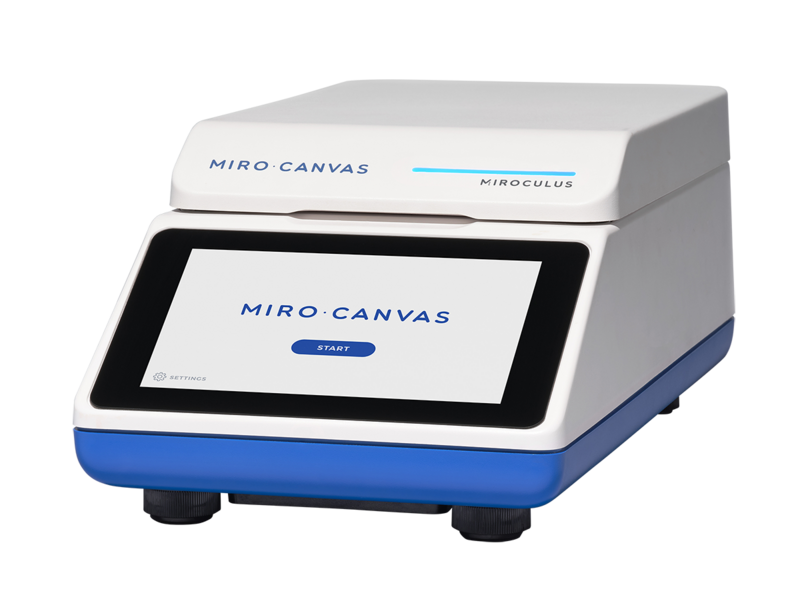
MIRO Cartridge
The MIRO Cartridge is a single use consumable suitable for running library prep workflows on the MIRO CANVAS instrument (for Research Use Only)
Part No. M-02-0001-001-03
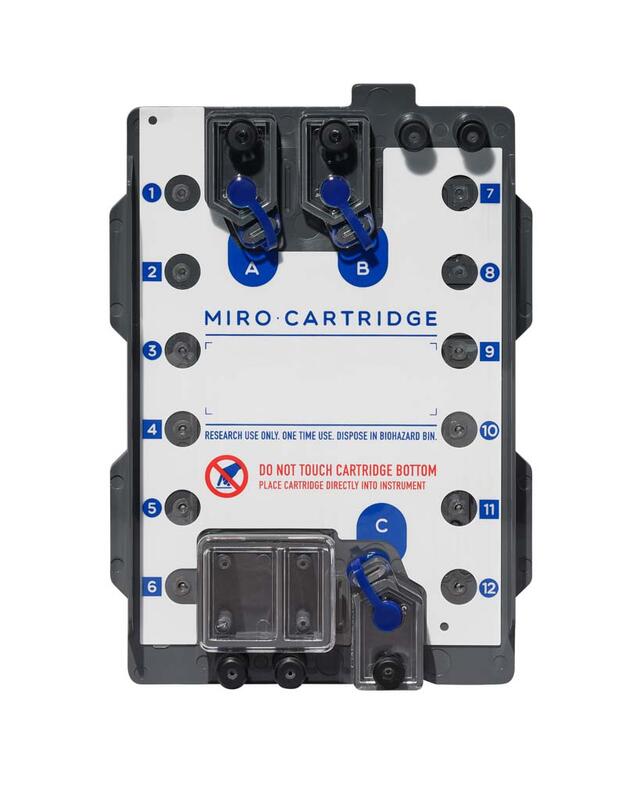
MIRO Dropgloss
MIRO Dropgloss is a proprietary system reagent that helps mitigate evaporation. (for Research Use Only)
Part No. M-03-0001-001-01
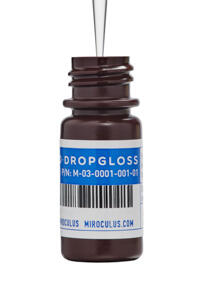
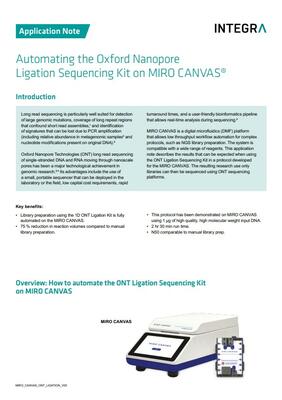
Downloads
Download App Note as PDF
DownloadAutomating the Oxford Nanopore Ligation Sequencing Kit on MIRO CANVAS®
